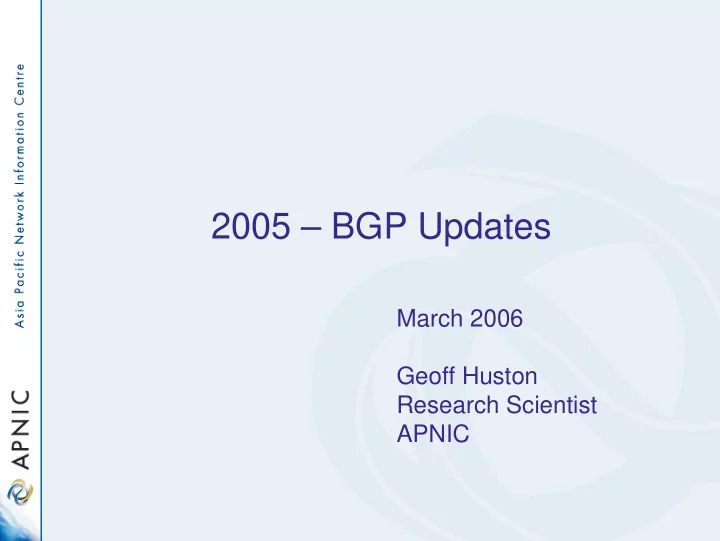

2005 – BGP Updates March 2006 Geoff Huston Research Scientist APNIC
BGP Update Study - Methodology • Examine update and withdrawal rates from BGP log records for 2005 from a viewpoint within AS1221 – Eliminate local effects to filter out non-DFZ BGP updates – Look at the relative rate of updates and withdrawals against the table size • Generate a BGP table size predictive model and use this to generate update rate and processing rate predictions
Update Message Rate
Prefixes per Update Message
Update Trends across 2005 • Number of update messages per day has doubled across 2005 (Dec 2005 saw approx 550,000 update messages per day) Considering the population size the daily rate is highly variable – why? • Number of prefixes per update message is falling from an average of 2.4 to 2.3 prefixes per update Is this attributable to ncreased use of public ASs and eBGP at the edge of the network? (Multi-homing?) • Is the prefix update rate increasing at a greater rate than the number of prefixes in the routing table? – Is there some multiplicative factor at play here? – Why is instability increasing faster than the network size?
Prefixes vs Updates • Look at the number of prefixes that are the subject of update messages • What are the trends of prefix update behaviour?
Prefix Update and Withdrawal Rates
Prefix Update Rates
Withdrawal Rates
Prefix Rate Trends • High variability in day-to-day prefix change rates • Best fit model appears to be exponential – although update and withdrawal rates show different growth rates
DFZ Prefix Table Size
1 st Order Differential
DFZ Model as an O(2) Polynomial 3 – 5 Year prediction
Relative Update / Withdrawal Rates
Update Rate Prediction
3-5 Year Predictions for the IPv4 DFZ • Today (1/1/2006) – Table Size 176,000 prefixes – Update Rate 0.7M prefix updates / day – Withdrawal Rate 0.4M prefix withdrawals per day • 3 Years (1/1/2009) – Table Size 275,000 prefixes – Update Rate 1.7M prefix updates / day – Withdrawal Rate 0.9M withdrawals per day • 5 Years (1/1/2011) – Table Size 370,000 prefixes – Update Rate 2.8M prefix updates / day – Withdrawal Rate 1.6M withdrawals per day
What’s the uncertainty factor? • Are we seeing a uniform distribution of updates across all ASs and all Prefixes? • Or is this a skewed heavy tail distribution where a small number of prefixes contribute to most of the BGP updates?
Prefix Stats • Number of unique prefixes announced: 289,558 • Prefix Updates: 70,761,786 • Stable prefixes: 12,640 • Updated prefixes (year end): 162,039 • Withdrawn prefixes: 127,519
Cumulative Distribution of Prefix Updates
Active Prefixes Top 10 Prefixes Prefix Updates Flaps Re-Homes 1. 202.64.49.0/24 198,370 96,330 918 2. 61.4.0.0/19 177,132 83,277 55 3. 202.64.40.0/24 160,127 78,494 1,321 4. 81.212.149.0/24 158,205 61,455 20,031 5. 81.213.47.0/24 138,526 60,885 12,059 6. 209.140.24.0/24 132,676 42,200 0 7. 207.27.155.0/24 103,709 42,292 0 8. 81.212.197.0/24 99,077 37,441 15,248 9. 66.150.140.0/23 84,956 11,109 5,963 10. 207.168.184.0/24 74,679 34,519 0
1 - 202.64.49.0/24
2 - 61.4.0.0/19
3 - 202.64.40.0/24
4 - 81.212.149.0/24
5 - 81.213.47.0/24
Distribution of Updates by AS
Distribution of Updates
Active ASNs Top 10 ASns AS Updates Flaps Re-Homes 1. 9121 970,782 349,241 206802 2. 7563 869,665 326,707 5 3. 702 605,090 232,876 144523 4. 17557 576,974 178,044 175275 5. 17974 569,806 198,948 310 6. 7545 562,879 200,425 8931 7. 721 498,297 175,623 35866 8. 2706 418,542 196,136 16945 9. 9950 411,617 148,725 6 10. 17832 393,052 143,018 0
1 – AS 9121
AS9121 Upstreams • 9121 TTNET TTnet Autonomous System Adjacency: 84 Upstream: 6 Downstream: 78 • Upstream Adjacent AS list AS1299 TELIANET TeliaNet Global Network AS3257 TISCALI-BACKBONE Tiscali Intl Network AS3356 LEVEL3 Level 3 Communications AS3549 GBLX Global Crossing Ltd. AS13263 METEKSAN-NET Meteksan.NET Autonomous System AS6762 SEABONE-NET Telecom Italia Sparkle
2 – AS 7563
3 – AS 702
4 – AS 17557
5 – AS17974
So what’s going on? • It would appear that the BGP update rate is being strongly biased by a small number of origins with two forms of behaviour: – Traffic Engineering - consistent update rates sustained over weeks / months with a strong component of first hop change and persistent announce and withdrawal of more specifics – Unstable configuration states – a configuration which cannot stabilise and for a period of hours or days the update rate is extremely intense
The Uncertainty Factor • Given that the overwhelming majority of updates are being generated by a very small number of sources, the level of uncertainty in extrapolation of trend models of BGP update rates is extremely high • This implies that the predictions of router capabilities in a 3 – 5 year interval is also extremely uncertain
Next Steps • Generate per-Prefix and per-AS views and update stats summaries in an on-demand rolling 31 day window • Correlation of path updates • Example reports follow:
209.82.241.0/24 15/3 – 17/3 Next-AS Hop changes Path changes UP / DOWN changes
61.0.0.0/8 15/3 – 17/3
Recommend
More recommend